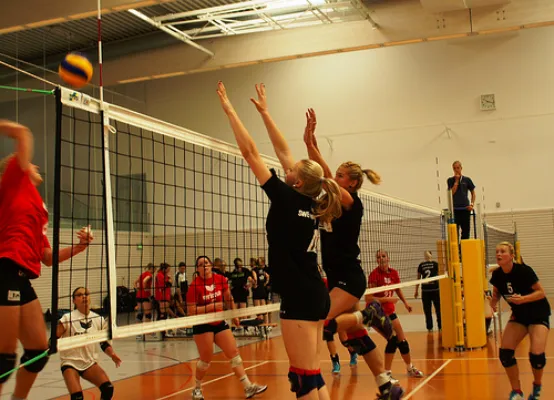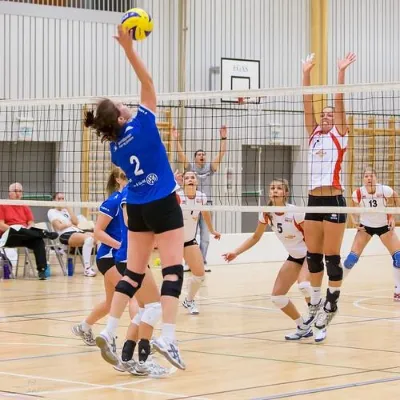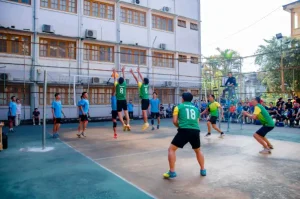Regulatory bodies like the International Volleyball Federation (FIVB) and various national associations define the standard dimensions of a volleyball court. A volleyball court is a rectangular area with the following key measurements:
- Length: The court measures 18 meters (59 feet) from baseline to baseline.
- Width: The width of the court is 9 meters (29.5 feet).
The court is symmetrical along the centerline, ensuring fairness for both competing teams.
| Dimension | Measurements |
|---|---|
| Length | 18 meters (59 feet) |
| Width | 9 meters (29.5 feet) |
| Net Height (Men) | 2.43 meters (7 feet 11 5/8 inches) |
| Net Height (Women) | 2.24 meters (7 feet 4 1/4 inches) |
| Attack Line Distance from Net | 3 meters (9 feet 10 1/8 inches) |
| Free Zone (Behind End Lines) | 6 meters (19 feet 8 1/4 inches) |
| Center Line Width | 5 centimeters (2 inches) |
| Antenna Length | 1.8 meters (5 feet 11 inches) |

Understanding Measurements for a Volleyball Court
Volleyball’s fast-paced rallies and dynamic plays depend on court dimensions. Discovering volleyball court dimensions is essential to understanding the game, whether you’re a pro or a beginner.
This research will reveal the dimensions, markings, and rules that make the volleyball court the familiar battleground we adore.

Baseline and Centerline: Dividing the Court
- Baseline: The baseline is the back boundary of the court. It spans the entire width and serves as the starting point for serving.
- Centerline: The centerline divides the court into two halves perpendicular to the baseline. It plays a crucial role in various aspects of the game, including serving and player positioning.
Attack Lines and Zones: Defining Offensive Plays
- Attack Lines: Also known as the 3-meter (10-foot) line, the attack lines are drawn parallel to the centerline on each side of the court. These lines indicate the boundary for back-row players during attacks. Front-row players are allowed to spike from behind the attack line.
Net Height and Antennae: Aerial Boundaries
- Net Height: Men’s volleyball nets are 2.43 meters (7 feet 11 5/8 inches), and women’s volleyball nets are 2.24 meters (7 feet 4 1/4 inches). Height is measured at the court center.
- Antennae: Antennae are vertical rods placed on each net side, extending 80 cm (2 feet 7 1/2 inches) above it. They serve as aerial extensions of the sidelines, helping officials judge the legality of plays near the net.
Free Zone: Ensuring Safety
- Free Zone: Beyond the court’s boundaries, a free zone or free space is designated to prevent collisions and ensure the safety of players. It extends at least 5 meters (16 feet 5 inches) from the sidelines and end lines.
Libero Area: Specialized Defensive Zone
- Libero Area: A specialized defensive player, known as the libero, has restrictions on where they can play. The libero must stay within the libero area, which is the back part of the court, behind the attack line.
Court Surface: The Foundation of Play
- Surface Material: While not a dimensional aspect, the playing surface is critical. It is typically made of wood or synthetic materials designed to provide consistent ball bounce and player traction.
Regulatory Considerations: Adhering to Standards
- Regulatory Bodies: Various volleyball associations and federations establish and enforce these court dimensions to ensure consistency across competitions. Adherence to these standards is crucial for fair play.
Impact of Court Dimensions on Gameplay
Understanding the dimensions of a volleyball court is not merely about memorizing numbers; it’s about appreciating how these measurements influence the game. The court’s size dictates the speed of play, the players’ positioning, and the teams’ defensive strategies.
As players serve, spike, and defend, they navigate this rectangular battleground with precision and method, all within the confines of the established dimensions.

FAQs
A size 5 volleyball is the standard for youth and junior players. It has a circumference of 65-67 centimeters and is smaller than the adult sizes, catering to the age and skill level of younger players.
The tactical placement of players on the court is referred to as spacing in volleyball. Sustaining appropriate distance facilitates successful teamwork, reduces overlaps, and maximizes both offensive and defensive tactics for optimal gameplay.
Volleyballs that are used indoors should weigh between 260 and 280 grammes (9.2 to 9.9 ounces). There may be small differences in the weights of beach volleyballs, but most of them are in the same range.
No, a standard volleyball is not heavier than a football. In general, a regulation volleyball weighs around 9 to 10 ounces, while a standard football typically weighs between 14 to 16 ounces.
Conclusion
In conclusion, the measurements for a volleyball court serve as the canvas on which the game’s drama unfolds. From the precision of a well-placed serve to the explosive power of a spike, every aspect of play is influenced by carefully defined boundaries.
Whether you’re a player striving for perfection or a fan cheering from the sidelines, a deeper understanding of these dimensions adds a layer of appreciation for the beauty and strategy embedded in the sport of volleyball.
So, the next time you watch a match, take a moment to marvel at the meticulous design of the court, where every meter and line contributes to the spectacle of volleyball action.
Related Posts
How Tall Is A Men’s Volleyball Net?
How To Set Up A Volleyball Net
Can you wear basketball shoes in volleyball

Hassan Baig a former volleyball player, coach and Administrative At Volleyplan.com.
My name is Hassan Baig and I am a former volleyball player and coach. I have a passion for the sport and have dedicated my life to promoting it. I have worked with some of the best players in the game and have helped them achieve their full potential Read More









